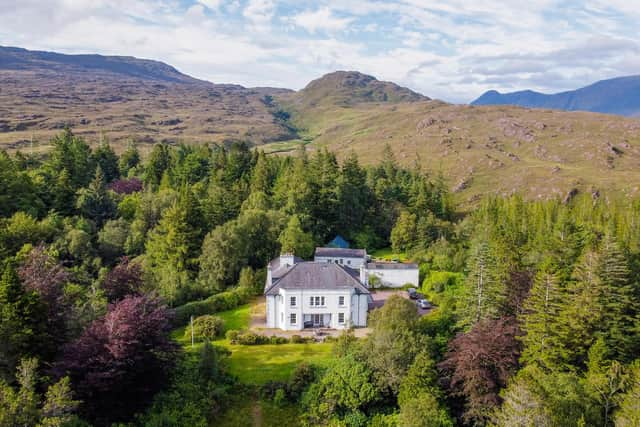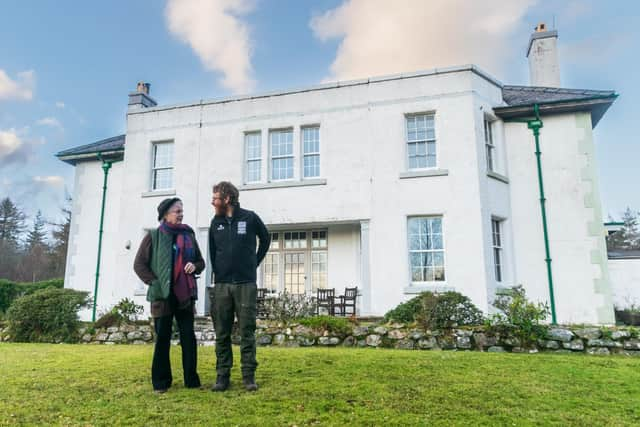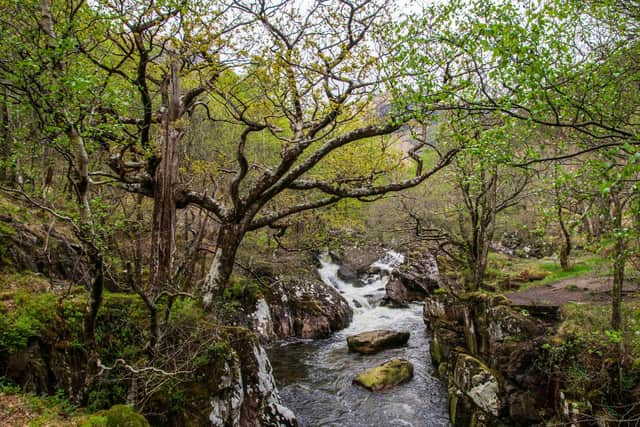New hub dedicated to Scotland’s rare Celtic rainforest to be set up at Couldoran in the west Highlands
The Scottish Rainforest Centre will be based at Couldoran House, a 95-year-old lodge on Couldoran estate, near Kishorn in Wester Ross.
It will focus on educational work and research related to conservation of the internationally important habitat and offer residential and events facilities.
Advertisement
Hide AdAdvertisement
Hide AdAlso known as Atlantic or temperate rainforest, the native woodlands are just as significant and even less common than their better-known tropical counterparts.
They are found on Scotland’s west coast, in the ‘hyper-oceanic’ zone, where cool summers, mild winters, wet conditions and clean air provide ideal conditions for some of the world’s rarest plants and fungi to thrive.
Couldoran House sits at the foot of the mountain Beinn Bhàn, a Corbett, and overlooks the start of the iconic Bealach na Bà – one of the steepest roads in the UK and the most famous section of the North Coast 500 touring route.
The site is set in the spectacular Wester Ross National Scenic Area and the Wester Ross Unesco Biosphere Reserve, part of Scotland’s rainforest zone.
The project is the brainchild of Australian-born environmental lawyer and activist Kathryn Rae, who has founded a new Scottish charity to purchase the property from Couldoran estate owner Woodland Trust Scotland.


Ms Rae has run her own environmental legal and management consultancy for the past 25 years, working for the EU, World Bank, the US Agency for International Development, Asia Development Bank and many national governments, and has expertise in both temperate rainforests in Scotland and tropical rainforests in Australia, Papua New Guinea and Costa Rica.
Woodland Trust Scotland, which owns Couldoran estate, has welcomed the establishment of the centre and will work in cooperation with the new charity.
“Scotland’s rainforest is one of our most precious habitats. It is as important as tropical rainforest, but even rarer, “ said Malcolm Turner, estate manager for Woodland Trust Scotland.
Advertisement
Hide AdAdvertisement
Hide Ad“Kathryn is an inspiring woman with a huge amount of experience. She is the ideal person to drive forward plans for the house to make a huge difference both locally and nationally.


“We bought Couldoran estate because it has great potential for woodland creation. We can get on with that while the Scottish Rainforest Centre does a complimentary job educating. It is a marvellous fit.”
The ten-bedroom house was built in 1928 by the son of a local landowning family.
It is located around 70 miles from the Highland capital Inverness, and is accessible via the A986 between Lochcarron and Shieldaig.
The two organisations will collaborate – Woodland Trust Scotland will continue its efforts to conserve and expand woodland in the wider area while the centre focuses on education and hosting visiting scientists.


“Plans are still being developed, however we aim to provide an ideal venue for events, workshops and meetings,” Ms Rae said.
“Accommodation options will be available for volunteers, students and academics. We want to host scientists working in the rainforest zone, but I am also very keen that local school children visit regularly and children from cities can stay and explore the rainforest and become involved in its conservation.
“The centre will also be available to the local community for non-woodland events.
Advertisement
Hide AdAdvertisement
Hide Ad“As a long-time supporter and life member of the Woodland Trust I was very excited by their rainforest conservation plans out on the estate, but when I saw the house I could see there was another job to be done – an interesting opportunity to support rainforest conservation.
“People have been waking up to the fact that Scotland has its own temperate rainforest along the west coast, and that action is needed to stop it disappearing. It seems to me that this emerging movement needs a physical hub and Couldoran House fits the bill.”
Woodland Trust Scotland, which also owns the nearby mountain Ben Shieldaig, purchased Couldoran estate in 2021.
The charity is currently working on plans to release land for local use.
Mr Turner added: “As responsible landowners and, we hope, good neighbours, we are looking into handing on some other parts of the estate, potentially for affordable housing.
“We are in discussions with the Communities Housing Trust to see what might be feasible. We recognise the need for community access to affordable land, access to affordable housing and empowerment of local communities to shape their own destinies.”
The estate contains existing native woodlands, including Scottish rainforests, plus land suitable for the creation of new woods.
Celtic rainforests – found in Argyll and the west Highlands, where the climate is wettest – are home to many globally scarce plants, including some that are unique to Scotland.
Advertisement
Hide AdAdvertisement
Hide AdMore than 500 species of mosses, ferns, lichens and liverworts have been recorded in these woodlands, which are characterised by native trees including ancient oak, ash, birch, hazel and Scots pine.
But as little as 30,000 hectares of Scottish rainforest remains across the country – this amounts to just two per cent of Scotland’s total woodland cover and only a fifth of the area with climatic conditions to support the habitat – and it’s feared this could be lost due to increasing threats from invasive alien species, fragmentation and poor management.
Comments
Want to join the conversation? Please or to comment on this article.
